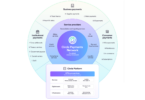Last week IHS Markit announced that is has completed the integration of the Cobalt post-trade foreign exchange (FX) blockchain platform with its MarkitSERV platform. Simultaneously, IHS Markit revealed a strategic investment in the startup.
While the financial details have not been disclosed, public filings point to IHS Markit investing £4 million ($5.2m) for a 9.5% stake in the company. Around the same time, there was an unidentified investment of £750,000 ($975,000) which may be from the Singapore stock exchange SGX because the share price was the same as the £2m SGX initial investment in May. If the additional investment is from SGX it would increase its shareholding from 4.8% to 6.6%. The investors in these two share issues were not identified in public records filed on 11 January.
The founders Adrian Patten and Andrew Coyne and their families still hold an evenly split 69% of the stock. Other key shareholders are First Derivatives with 7.8%, former Blackrock fund manager Mark Wharrier with 1.4%, and Digital Currency Group with 0.4%.
The news means that Cobalt has access to over 800 FX counterparties which use MarkitSERV’s global network. MarkitSERV provides management of trade confirmation, clearing, allocation of block trades and regulatory reporting across multiple asset classes. In 2009 MarkitSERV was jointly founded by Markit and the DTCC with the aim of providing trade processing for OTC derivatives. Markit bought out the DTCC stake in 2013 and the network extended the asset classes.
The benefit of Cobalt’s platform is it creates a single shared version of an FX transaction and hence should remove the need for reconciliations. Additionally, it offers netting and aggregation thereby reducing the number of trades.
“This collaboration marks the start of a major transformation in FX infrastructure,” said Chris Leaver, managing director and head of FX at MarkitSERV. “The majority of the FX industry is already integrated with the MarkitSERV network and we now offer the community turn-key access to the Cobalt platform and the opportunity to radically streamline post-trade workflows. This partnership is a natural extension of MarkitSERV’s core strategy of centralizing and normalizing post-trade processing across all asset classes.”
The announcement said that post-trade processing costs the FX industry billions of dollars a year. In a 2017 interview with Tabb Forum, Cobalt co-founder Andy Coyne said: “Everyone persists their own version of transactions, multiple times, multiple systems, and that adds up to about $20 billion worth of expense.”
Last week Cobalt Chairman and co-founder Adrian Patten said: “For too long, FX has been burdened by an aging, inefficient post-trade environment. Our high-performance technology has been designed to replace legacy infrastructure and inefficient processes, as well as significantly slash cost and risk for this five trillion dollar a day market.”
How it works
In the Tabb Forum interview, CEO Andy Coyne asked: “Did the buyer and seller agree, did they book it correctly? Did it agree with the venue they traded on?” He continued: “You have to make sure that the contract abided by the trading rules that were set down before the execution happened.”
“Once you’ve passed those rules we create a unique copy of that transaction. We post it to the ledger. And the ledger is then the repository for all the golden trade copies.”
Cobalt runs a series of services against the ledger which includes netting and aggregation creating fewer transactions to settle. So not only should the need for reconciliation go away but there will be fewer transactions to settle which will also save money.
CLS
Two months ago, another blockchain-based FX solution went live, CLSnet. CLS runs the systemically important FX netting and settlement system called CLS Settlement. That’s not blockchain-based and processes $5 trillion in FX payments daily. However, it only deals with 18 major currencies, so CLS with help from IBM created CLSNet a blockchain-based system to deal with the other 120+ currencies.
A reasonable proportion of Cobalt’s transactions are likely to settle on CLS Settlement or CLSnet.
Back in 2017 Cobalt’s Coyne didn’t think the change would happen overnight. “In the medium to long term, as people migrate their relationships onto the ledger infrastructure the dependency on legacy is reduced with a goal to being replaced over time,” said Coyne. With the latest announcement, that goal moved a step closer.






